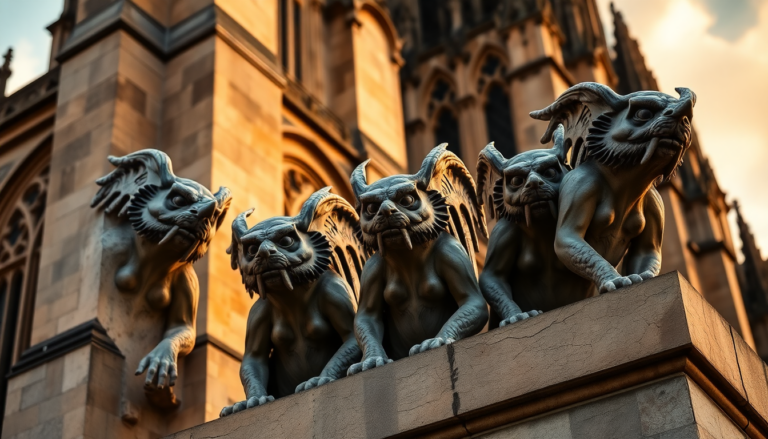Argomenti trattati
Have you ever gazed up at a cathedral and felt a shiver run down your spine? Those grotesque figures, the gargoyles, are more than just stone decorations; they are ancient sentinels with a captivating history. These mythical sculptures, often misunderstood as mere ornaments, actually served practical purposes as well as symbolic roles, protecting buildings from water damage while warding off evil spirits. Let’s embark on a journey to uncover the secrets of these fascinating creatures that adorn structures across the globe.
The origins of gargoyles
To truly appreciate gargoyles, we must rewind to the medieval era, around the 12th century. As I wandered through the narrow streets of Paris, I remember standing before the magnificent Notre Dame Cathedral, feeling dwarfed by its towering spires. It was here that I first learned about the dual role of gargoyles. Originally designed as drainage systems, these creatures allowed rainwater to flow away from buildings, preventing the wear and tear caused by moisture. Their mouths, wide open, acted as conduits, channeling rain away from vulnerable stonework. But why choose such bizarre forms for a functional purpose? The answer lies in the rich symbolism of the time.
During the medieval period, fear of the supernatural was rampant. Gargoyles, with their monstrous visages, were believed to serve as spiritual guardians, protecting the faithful from malevolent spirits. Their grotesque features were not merely for show, but a means to intimidate evil forces. They became the silent watchers, keeping a vigilant eye over the congregations inside the churches. Imagine the stories they could tell if they could speak! With every glance upwards, you could sense their ancient wisdom lurking just beneath the surface.
The evolution through the ages
As we move to the Renaissance and Baroque periods, the role of gargoyles began to shift. While their practical function diminished due to advancements in architecture, their aesthetic appeal grew. I found myself enchanted by the intricate designs of gargoyles on structures like St. Peter’s Basilica in Rome. The transition from utilitarian to ornamental is fascinating—these stone creatures evolved into symbols of artistic expression.
Even as architectural styles changed, gargoyles remained fixtures on churches and cathedrals, often reimagined in more whimsical or romantic forms. The Neogothic revival in the 19th century saw a resurgence of interest in these creatures, with many new buildings incorporating gargoyles to evoke a sense of history and mystery. They became emblematic of a bygone era, whispering tales of yore to those who dared to look up.
Gargoyles in popular culture
Fast forward to the 20th century, and gargoyles found a new lease on life within popular culture. I recall sitting in a dimly lit theater, captivated by Disney’s “The Hunchback of Notre Dame.” The gargoyles in the film were not just decorations; they became lively characters, providing comic relief and friendship to Quasimodo. This portrayal sparked a renewed interest in these mythical beings, transforming them from relics of the past into beloved figures of modern storytelling.
From animated films to television series, the image of gargoyles as protectors of the night became widespread. They were no longer just stone figures fixed in place; they became dynamic characters filled with personality and charm, often depicted as guardians coming to life under the moonlight. Who knows? Maybe they’re watching over us even now, ready to leap into action at a moment’s notice!
A journey to find gargoyles
Today, while their original function as water conduits has faded, gargoyles remain integral to our architectural landscape, beckoning travelers to discover their hidden stories. When exploring Europe, it’s impossible to miss their presence—particularly in countries like France and Germany, where gothic architecture flourished. With each step, you might stumble upon a gargoyle peering down at you, its expression frozen in time. I remember the thrill of finding a particularly unique one in a small, forgotten church in the French countryside; it felt like I had uncovered a piece of history.
But it’s not just Europe that boasts these stone sentinels. The influence of Neogothic architecture has spread to other continents, including North America and Australia. Look up at the towering cathedrals and historic buildings in cities like New York or Melbourne, and you might just spot a gargoyle keeping watch from the rooftop. They’ve become cultural icons, bridging the past and present, reminding us of the rich stories embedded in our architectural heritage.
The significance of gargoyles today
In a world where modern engineering has rendered their original purpose obsolete, gargoyles now serve as reminders of an era when art, religion, and functionality were intertwined in a single form. They embody not just architectural beauty but also the complex interplay of history, mythology, and human emotion. As I wander through cities and stumble upon these stone figures, I can’t help but feel a sense of connection to the past, a reminder of the beliefs and fears that shaped our ancestors’ lives.
Next time you visit a cathedral or a historic building, take a moment to look up. Those gargoyles, with their fierce faces and dramatic poses, are waiting to share their stories. They may be silent, but their presence speaks volumes about the human experience, the tales of protection, fear, and creativity that have persisted through the ages. In the end, gargoyles remind us that even in stone, there is life, history, and a touch of magic.

